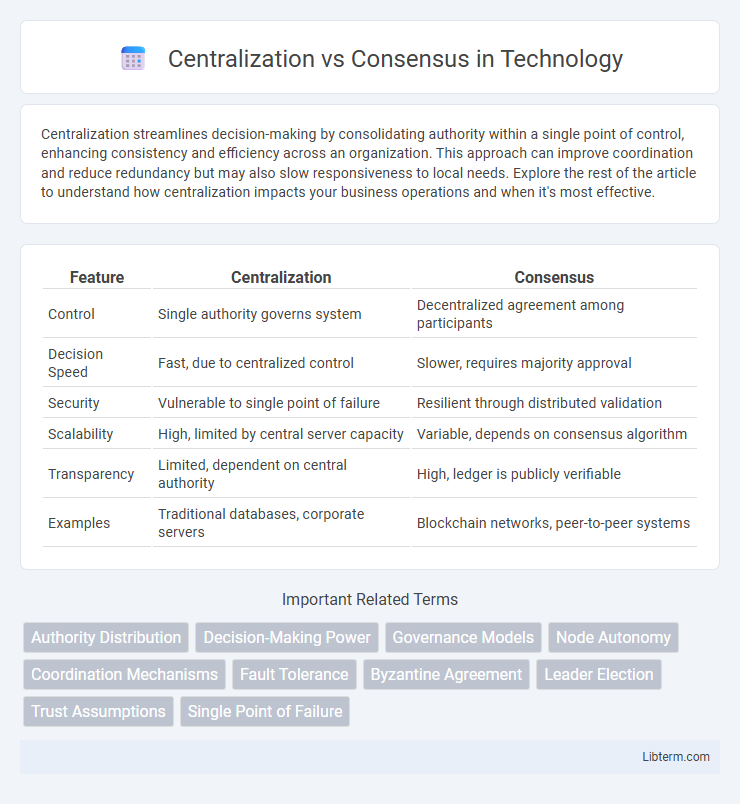Centralization streamlines decision-making by consolidating authority within a single point of control, enhancing consistency and efficiency across an organization. This approach can improve coordination and reduce redundancy but may also slow responsiveness to local needs. Explore the rest of the article to understand how centralization impacts your business operations and when it's most effective.
Table of Comparison
| Feature | Centralization | Consensus |
|---|---|---|
| Control | Single authority governs system | Decentralized agreement among participants |
| Decision Speed | Fast, due to centralized control | Slower, requires majority approval |
| Security | Vulnerable to single point of failure | Resilient through distributed validation |
| Scalability | High, limited by central server capacity | Variable, depends on consensus algorithm |
| Transparency | Limited, dependent on central authority | High, ledger is publicly verifiable |
| Examples | Traditional databases, corporate servers | Blockchain networks, peer-to-peer systems |
Understanding Centralization: Key Concepts
Centralization refers to the concentration of decision-making authority within a single entity or a small group, streamlining control and enhancing efficiency in managing resources. Key concepts include hierarchical structure, where power flows from a top-level authority, and reduced redundancy, which simplifies coordination and enforcement of policies. Understanding these principles highlights how centralization impacts speed, accountability, and risk, contrasting with decentralized consensus models.
What is Consensus in Distributed Systems?
Consensus in distributed systems is a fundamental process that ensures all nodes agree on a single data value or system state, despite failures or message delays. It enables coordination and consistency across decentralized networks by achieving agreement through algorithms like Paxos, Raft, or Byzantine Fault Tolerance protocols. This mechanism underpins the reliability and fault tolerance essential for blockchain, distributed databases, and multi-agent systems.
Centralization vs Consensus: Core Differences
Centralization concentrates decision-making authority within a single entity or a select group, ensuring faster execution and streamlined control. Consensus requires collective agreement from multiple participants, enhancing transparency and decentralization but often leading to slower processes. These core differences impact scalability, security, and trust models across various systems, including blockchain networks and organizational structures.
Benefits of Centralized Systems
Centralized systems offer streamlined decision-making by consolidating authority, which enhances operational efficiency and reduces the time required to implement actions. These systems improve data consistency and security by maintaining control within a single entity, minimizing discrepancies and unauthorized access. Centralization also facilitates easier management of resources, enabling organizations to quickly adapt to changes and enforce policies uniformly across the entire network.
Advantages of Consensus Mechanisms
Consensus mechanisms enhance network security by ensuring that all participants validate transactions, reducing the risk of fraud and double-spending. They promote decentralization, which increases transparency and resilience against single points of failure. Additionally, consensus protocols foster trustless environments where nodes can independently verify data integrity without relying on a central authority.
Risks and Limitations of Centralization
Centralization in decision-making concentrates authority in a single entity or group, increasing the risk of single points of failure, reduced transparency, and potential for unchecked power abuse. This structure often leads to slower responses in dynamic environments due to hierarchical bottlenecks and limits the diversity of perspectives essential for robust problem-solving. Moreover, centralized systems face scalability challenges and vulnerability to targeted attacks, making them less resilient compared to decentralized consensus models.
Challenges in Consensus-Based Architectures
Consensus-based architectures face significant challenges including scalability limitations due to the need for multiple nodes to validate transactions, which increases latency and reduces throughput. The complexity of achieving agreement in large, decentralized networks results in higher energy consumption and vulnerabilities to certain attack vectors like Sybil or 51% attacks. Balancing security, decentralization, and performance remains a core difficulty in consensus mechanisms such as Proof of Work, Proof of Stake, and Byzantine Fault Tolerance.
Real-World Examples: Centralized vs Consensus Models
Centralized models like traditional banking systems control financial transactions through a single authority, exemplified by institutions such as JPMorgan Chase, which maintain strict regulatory oversight and faster transaction processing. Consensus models underpin blockchain networks like Bitcoin and Ethereum, where decentralized nodes validate transactions through protocols such as proof-of-work or proof-of-stake, ensuring transparency and resistance to censorship. Real-world applications show centralized systems offer efficiency but risk single points of failure, while consensus models provide security and decentralization at the cost of scalability and speed.
Choosing the Right Approach: Factors to Consider
Choosing between centralization and consensus depends on factors such as decision-making speed, stakeholder alignment, and system complexity. Centralization offers faster resolutions by relying on a single authority, ideal for environments requiring quick, clear directives. Consensus fosters inclusive decision-making and higher commitment but may slow processes, making it suitable for collaborative or decentralized systems.
The Future of Decentralized Consensus vs Centralized Control
Decentralized consensus mechanisms, such as blockchain and distributed ledger technologies, are transforming the future of governance by enhancing transparency, security, and resilience against single points of failure. Centralized control systems, while efficient for rapid decision-making, face challenges related to trust, censorship, and vulnerability to attacks or corruption. The evolution toward decentralized consensus models promises a more democratic and robust infrastructure, increasingly favored in sectors like finance, supply chain, and digital identity management.
Centralization Infographic

 libterm.com
libterm.com